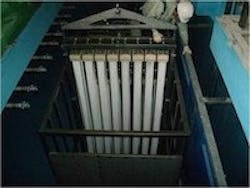Vermont Town Registers Cost Savings with MBR Technology
A small Vermont town is experiencing significant cost savings and improved efficiency after replacing original wastewater treatment membranes with high-performing Layne Poreflon membrane bioreactor (MBR) membranes. First settled nearly 230 years ago and now home to approximately 1,500 residents, the town of Cabot installed an MBR plant in 2001 to eliminate residential septic tank discharges into the headwaters of the Winooski River.
The original membranes met the town's operational expectations and lifespan projections for the first nine years. However, after the town replaced the original membranes with used membranes in 2010, fibers began to pull out of the potting, resulting in increased finished water turbidity. Meanwhile, the manufacturer stopped making the original membranes that fit Cabot's small system, which serves approximately 100 customers.
Cabot heard about Layne’s Poreflon MBR product after a Layne water treatment engineer made a presentation about the chemical-resistant membranes. Cabot followed up on Layne's remedy in May 2012. By late November, both replacement Poreflon MBR trains were installed and operating.
Benefits of the Layne solution quickly became apparent.
Layne’s membranes reduced the air scour to 48 standard cu ft per minute (SCFM) compared to 70 SCFM with the old membranes. Because of this, the town was able to eliminate one of two 10-hp blowers. The town was awarded a grant towards the purchase of the Layne Poreflon membranes from the Vermont Energy Investment Corp. due to the reduction in energy usage.
The new membranes also feature a capacity of 52 gal per minute (gpm), which is approximately 48% higher than the original 35-gpm membranes.
The Layne membranes are also less labor intensive than the original membranes. The fact that Cabot won’t be pulling the racks every two weeks and physically cleaning the membranes should extend the life of the membranes because they are being handled less. In addition, they estimate more than 40 man-hours will be saved each year due to the standard in-line cleaning recommended for the Poreflon membranes.
The Layne Poreflon MBR is more rugged with its stainless-steel construction. The layout allows plenty of space between each module and the one-piece fiber that wraps around the bottom with potting only at the top allows for better air scour. The old system’s layout and air scour created a funneling effect that caused sludge to accumulate towards both the bottom and top potting.
The operator continues to monitor the operations of the Cabot plant and is considering replacing the membranes at other MBR facilities they operate with the Layne Poreflon membranes.
The Poreflon is a registered trademark of Sumitomo Electric Fine Powder Inc.
Dongxu Yan is research and development engineer for Layne. Yan can be reached at [email protected] or 602.345.8550. Jim Groose is business development manager for Layne. Groose can be reached at [email protected] or 262.346.4646.
